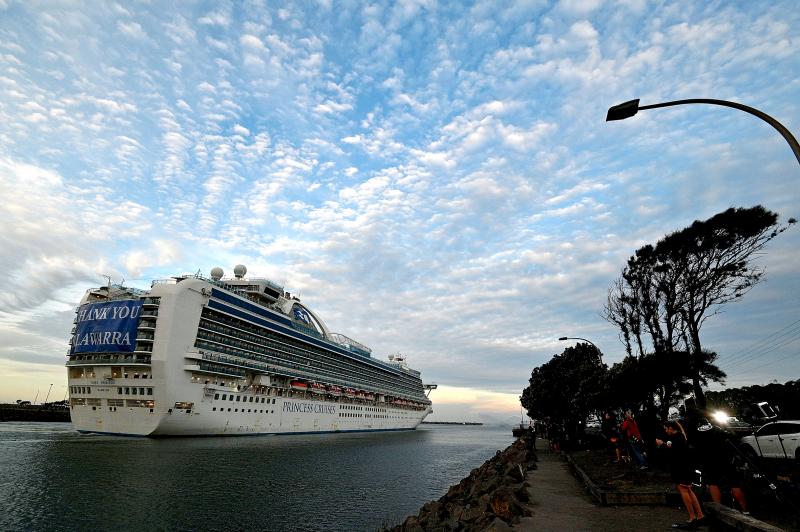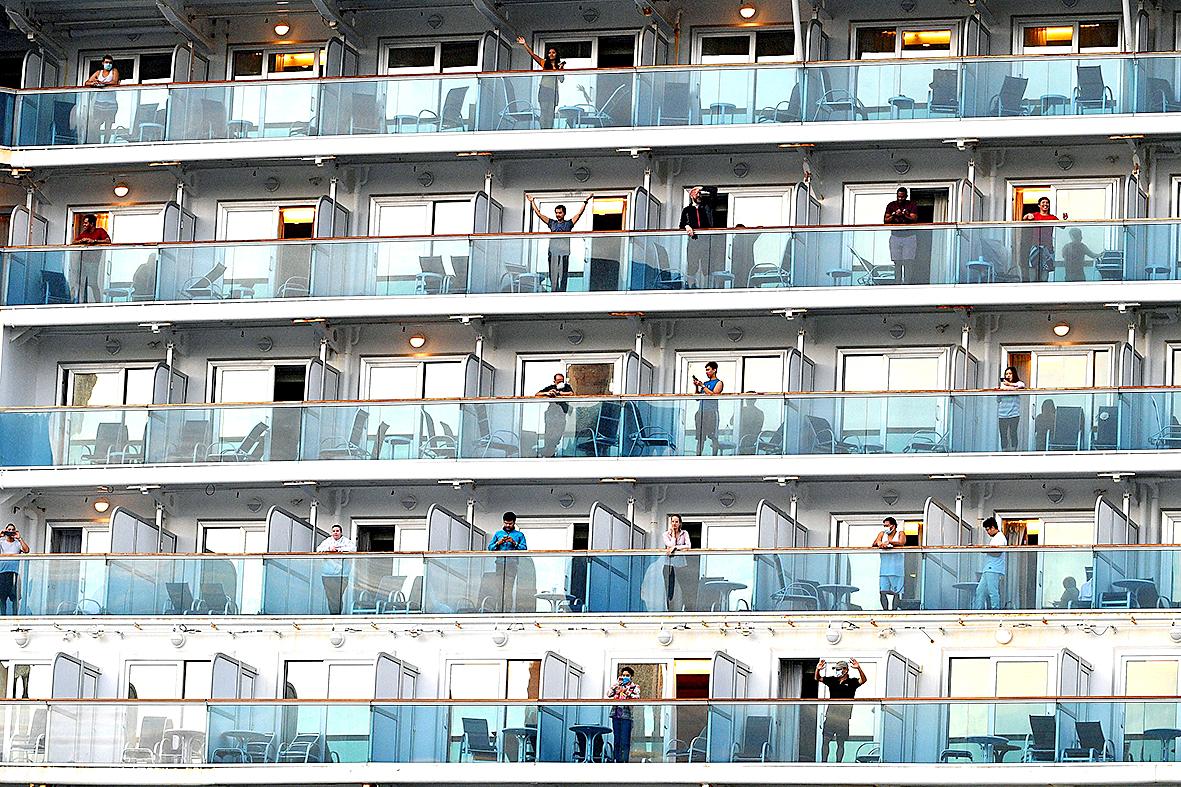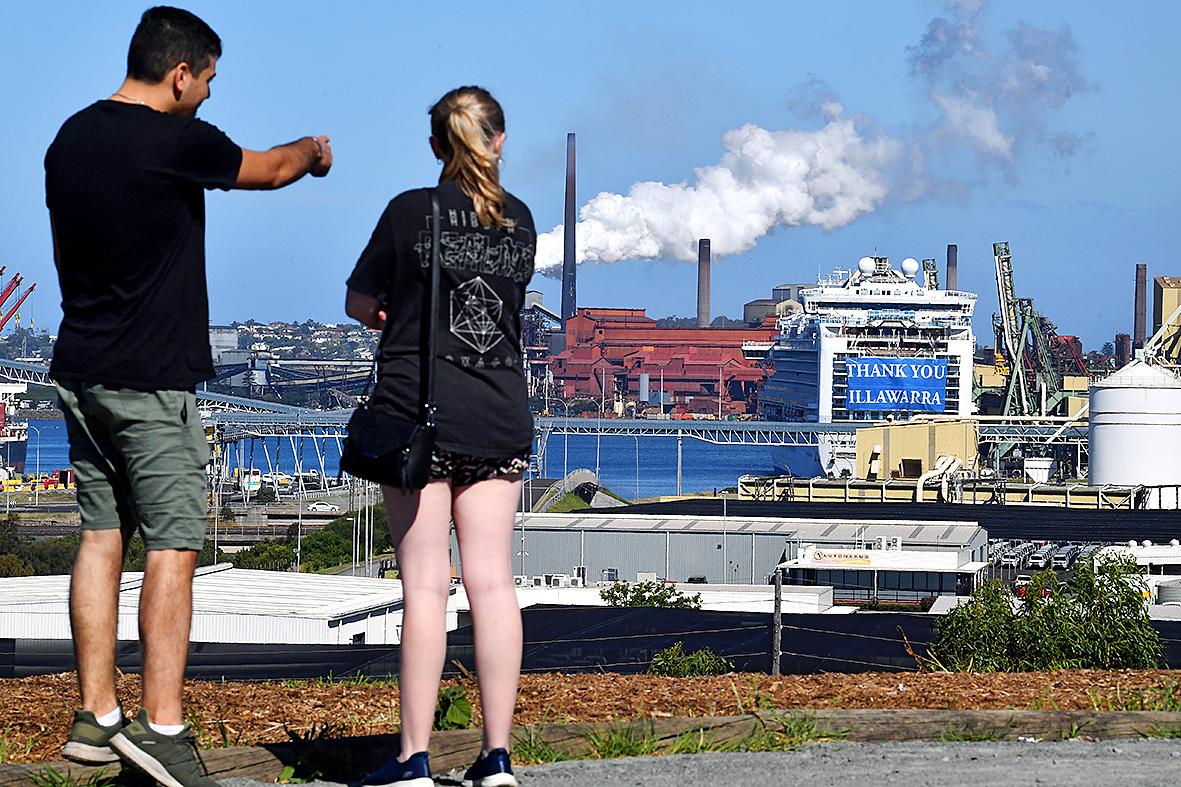The Celebrity Solstice was given a civic reception when it docked in Newcastle in 2014. The lord mayor wore his robes and chains and personally welcomed passengers to the city; such was the pageantry required for a destination to impress the cruise industry in the hope of sharing in some of its spoils.
Thousands lined the waterfront in Darwin, Brisbane and Sydney to glimpse the Ovation of the Seas — the largest cruise liner to operate in Australia — when it first docked in those cities.
This month those same ships, along with about a dozen more, were ordered to leave Australian waters without ceremony.

Photo: AFP
More than 700 passengers from one ship alone, the ill-fated Ruby Princess, have been infected with COVID-19, and at least 21 have died. Almost 200 crew members among the 1,000 who were still on board at Port Kembla on Tuesday have tested positive, and the ship’s final cruises are now the subject of a criminal investigation, at least one private lawsuit and a potential class action.
Both Celebrity Solstice and Ovation of the Seas have also been linked to coronavirus cases and at least one death each, and the banishment of these floating cities marks an unprecedented and sudden rebuke for an industry that has grown rapidly in size and influence during the past two decades.
More than 1.35 million Australians took an ocean cruise in 2018 — a tenfold increase since 2002. During that period, governments and local councils around the coastline have hatched plans to dredge waterways and construct passenger terminals to accommodate larger liners and more frequent visits. Many of those proposals are now in limbo, amid uncertainty about when — or if — the cruise industry will recover.

Photo: AFP
The industry has for several years been agitating for another Sydney terminal to allow for increased traffic during peak season and to cater for larger ships that cannot dock at existing berths in Sydney Harbor.
The New South Wales government had been considering two sites — at Yarra Bay and nearby Molineux Point on Botany Bay — and was understood to be on the verge of approving the project. The process has now been shelved for 18 months.
“We have got new people coming to the campaign every day now,” says Maria Poulos from the Save Yarra Bay Coalition, which opposes the proposal.

Photo: EPA-EFE
“I thought we would lose momentum after that announcement, but what’s happened is we’ve had an increase in membership. Obviously there’s been attention on the business practices of the cruise industry and the cosy relationships governments have with the cruise industry.”
Poulos says the coronavirus situation has highlighted the need for sustainable, environmentally-friendly tourism and argues the state should consider a cap on cruise ships in Sydney.
‘A BAD NEIGHBOR’
The remarkable growth in cruise tourism in Australia has occurred at the same time as several uncomfortable revelations about the cruise industry — onboard incidents such as the death of Dianne Brimble in 2002, virus outbreaks amplified by the confined quarters and concerns about pollution and environmental practices.
Attracting cruise visits has often been sold by proponents as an economic panacea that outweighs environmental and community concerns.
But those who live near terminals are often much less enthusiastic.
“The cruise industry has been a very bad neighbor for residents in White Bay and Balmain,” says Darcy Byrne, the mayor of Sydney’s Inner West council.
Residents of Balmain have long complained about pollution and noise from liners parked at White Bay since the area was opened as the city’s second cruise terminal in 2013. Because there is no shore-to-ship power at the berth, vessels sitting idle in the harbor are powered by bunker fuel. Regulations to lower bunker fuel emissions were first put in place in Sydney Harbor in 2015.
“The thing that’s always rankled is that we were told the reason we had to have a cruise ship terminal at White Bay was because the industry was going gangbusters and it was such a crucial part of our economy and our tourism sector,” Byrne said.
“If you’re going gangbusters you can surely afford some basic environmental protection so you don’t burn bunker fuel near people’s homes.”
Byrne said communities where terminals were proposed should “heed the lessons from Balmain.” They included the need for environmental protections and to ensure communities impacted by development then had some stake in the economic benefits.
“Don’t let the facility open there without proper environmental protections being in place in the first place,” Byrne says. “We all accept that tourism is vital and important and I’m personally very scared about the impact on our wider economy. But there’s been essentially zero economic benefit for the main street in Balmain and our local economy for having the passenger terminal there for the past five years. We basically didn’t get a single dollar of economic benefit out of it.”
‘DO WE EVEN WANT THEM?’
On the Gold Coast, the local council has developed an unconventional plan to attract the cruise industry to a region with no deepwater harbor. The city wants to build a 1.2km jetty from The Spit to allow ships to dock in the ocean and passengers to disembark on the glitter strip.
The Queensland tourism minister, Kate Jones, said last week that earmarked projects such as the Gold Coast terminal were likely to be delayed, but the local mayor, Tom Tate, has indicated his desire to proceed with the planning process.
Steve Gration, from the community group Save Our Spit, said the council’s feasibility studies had raised serious questions about the terminal’s viability and ability to attract investment, even before the coronavirus outbreak.
Gration said the coronavirus situation meant any planning would now need to be revised.
“If they weren’t coming before, how many [cruise ships] are going to come now, and do we want them? Do we even want them coming to a place that is predominantly tourism and education centered ... do we want our workforce to be decimated by these diseases on the small chance that passengers might spend a few dollars on a Surfers Paradise T-shirt? I don’t think the risk is warranted.
Gration said the order by the Queensland premier, Annastacia Palaszczuk, for cruise ships to leave the state was a signal that support for the industry was “at an all-time low.”
“I think there was a clear indication in that moment that the honeymoon period of cruise ships and Queensland, they’re not in the good books.”
A new cruise terminal at Luggage Point in Brisbane is due to open in October. The Port of Brisbane has said that, given the state has a temporary ban on cruising in place, it is “too early to understand” when the first ships will dock and how the facility will be affected in the long term.
‘PEOPLE WILL GET BACK OUT TO SEA’
Most in the cruise industry and other observers believe it is too early to properly understand how the sector will be changed, and how quickly it can recover, from the impact of the coronavirus crisis.
“Cruise travel, you would expect to be sitting right towards the end, if not the very last thing, that is reactivated again, given the difficulties Australia has faced with the cruise sector,” the tourism minister, Simon Birmingham, has said.
Remarkably, some reports suggest an increase in the number of cruise bookings for next year, as passengers use credits to reschedule voyages canceled due to the coronavirus crisis.
“Cruising has been embraced by so many Australians over the past 10 years and I believe that once it is safe for us to socially integrate and travel, people will get back out to sea,” says Jill Abel, the chief executive of the Australian Cruise Association, the industry’s cooperative marketing arm.
“The work that we have done with local and state governments developing access to regional ports around the country will definitely be an asset in getting Australian cruise passengers out to the regional areas that they may not have planned to visit prior to this. Cruise will therefore play a vital role in the recovery of local tourism in communities that have done it tough since Christmas.”
Abel says the industry hopes to resume discussions with governments about future infrastructure needs “when the timing is right in the future.”
The managing director of the Cruise Lines International Association, Joel Katz, says infrastructure planning should be a long-term process and take into account developments many years into the future. He says Clia member cruise lines introduced new screening protocols within 48 hours of the WHO declaring a public health emergency, and the cruise industry was the first to voluntarily suspend operations worldwide.
“Australians in particular have a passion for cruising, which is reflected in this region having the highest market participation rate of any major established cruise market in the world,” Katz says.
“The cruise industry is deeply connected to the Australian community and to the Australian economy, and we believe our industry has the resilience and responsibility to overcome the challenges ahead.
“Clia is now working with its members, medical experts and global health authorities on the changes our industry will need to make in our future operations in order to move forward and be successful in a world impacted by COVID-19.”

Oct. 27 to Nov. 2 Over a breakfast of soymilk and fried dough costing less than NT$400, seven officials and engineers agreed on a NT$400 million plan — unaware that it would mark the beginning of Taiwan’s semiconductor empire. It was a cold February morning in 1974. Gathered at the unassuming shop were Economics minister Sun Yun-hsuan (孫運璿), director-general of Transportation and Communications Kao Yu-shu (高玉樹), Industrial Technology Research Institute (ITRI) president Wang Chao-chen (王兆振), Telecommunications Laboratories director Kang Pao-huang (康寶煌), Executive Yuan secretary-general Fei Hua (費驊), director-general of Telecommunications Fang Hsien-chi (方賢齊) and Radio Corporation of America (RCA) Laboratories director Pan
The consensus on the Chinese Nationalist Party (KMT) chair race is that Cheng Li-wun (鄭麗文) ran a populist, ideological back-to-basics campaign and soundly defeated former Taipei mayor Hau Lung-bin (郝龍斌), the candidate backed by the big institutional players. Cheng tapped into a wave of popular enthusiasm within the KMT, while the institutional players’ get-out-the-vote abilities fell flat, suggesting their power has weakened significantly. Yet, a closer look at the race paints a more complicated picture, raising questions about some analysts’ conclusions, including my own. TURNOUT Here is a surprising statistic: Turnout was 130,678, or 39.46 percent of the 331,145 eligible party

The classic warmth of a good old-fashioned izakaya beckons you in, all cozy nooks and dark wood finishes, as tables order a third round and waiters sling tapas-sized bites and assorted — sometimes unidentifiable — skewered meats. But there’s a romantic hush about this Ximending (西門町) hotspot, with cocktails savored, plating elegant and never rushed and daters and diners lit by candlelight and chandelier. Each chair is mismatched and the assorted tables appear to be the fanciest picks from a nearby flea market. A naked sewing mannequin stands in a dimly lit corner, adorned with antique mirrors and draped foliage

The election of Cheng Li-wun (鄭麗文) as chair of the Chinese Nationalist Party (KMT) marked a triumphant return of pride in the “Chinese” in the party name. Cheng wants Taiwanese to be proud to call themselves Chinese again. The unambiguous winner was a return to the KMT ideology that formed in the early 2000s under then chairman Lien Chan (連戰) and president Ma Ying-jeou (馬英九) put into practice as far as he could, until ultimately thwarted by hundreds of thousands of protestors thronging the streets in what became known as the Sunflower movement in 2014. Cheng is an unambiguous Chinese ethnonationalist,